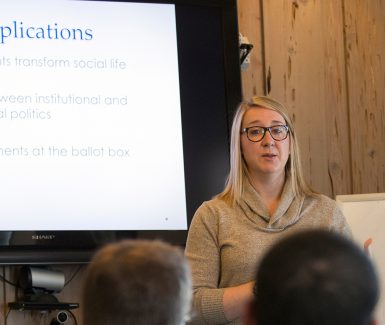Research presentations feature investigative reporting, same-sex marriage movement

Two IU Journalism professors shared their research on the features of award-winning investigative reporting and how a ban on same-sex marriage galvanized a movement.
Assistant professor Gerry Lanosga presented “Media and Policy Agenda Building in Investigative Reporting, 1979-2012” and assistant professor Laura Meadows presented “Losing Forward: An Ethnographic Study of the LGBT,” during IU Journalism’s weekly research colloquium series in Ernie Pyle Hall Friday.
A glimpse into the investigative process
The relationship between reporters and sources is often compared to that of a ventriloquist and dummy, but that may not actually be the case.
“That ventriloquist dummy model may be overstated,” Lanosga said.
His research found a reporter initiated almost half of the investigative reporting stories reviewed during the research project, while roughly 34 percent started with tips from sources.
Lanosga worked with DePaul University assistant professor Jason Martin, PhD’11, to analyze contest entry questionnaires submitted to Investigative Reporters and Editors for the organzation’s annual awards from 1979-2012. The pair took a random sample of more than 22,000 entries, which encompassed print, broadcast and online news organizations.
The questionnaires allowed them to get a glimpse into the process that generated the stories, Lanosga said, and how the story got started was a lynchpin of their research. The pair’s research sought to find out the general attributes of investigative projects; what initiated the story and what source material was used; and what policy agenda-building consequences resulted.
The preliminary results found that in the 1970s, newspapers conducted the most investigative reporting but that has been on a downward trend recently while online investigative reporting has increased. Most investigative reporting deals with government or business, Lanosga said.
The research distinguished between stories that started with a reporter’s hunch or initiation and those that came from a tip from a source. Lanosga said the research delved into what types of human sources the investigative pieces used and found that 78.9 percent used official or government sources and 60 percent used real people.
An interesting trend is that stories are increasingly using documents obtained through freedom of information requests and data, Lanosga said.
“It jumps up pretty sharply over the course of five decades,” he explained. “We think this is a balance to human source influence.”
Last, Lanosga and Martin looked at whether investigative stories resulted in changes to the policy agenda. Lanosga said the research found that 45.4 percent of the stories resulted in legislation and administrative or judicial action; 28 percent prompted an administrative investigation; and 16 percent resulted in an arrest, firing or disciplinary action against story subjects.
Lanosga said they looked at whether stories that are tip driven or reporter initiated resulted in policy change or action. Tip-based stories produced policy results 78 percent of the time, while enterprise stories produced results 66 percent of the time, he said.

‘A debate where silence had reigned’
When North Carolina voters passed a constitutional amendment to ban same-sex marriage, they galvanized the LGBT movement in the state.
“Amendment One sparked a debate where silence had reigned,” Meadows said.
Meadows’ work centered on a “catalyzing event” and how that impacted a social movement, such as the LGBT movement in North Carolina. First-hand observations, personal interviews and attending events informed Meadows’ research during the Amendment One campaign.
“I saw how Amendment One transformed the movement,” she said.
In September 2011, the North Carolina General Assemble passed a ballot measure that sought to amend the state’s constitution and ban same-sex marriage. On May 8, 2012, that amendment — known as Amendment One — passed with 61 percent of the vote, only to be thrown out by a federal court two and a half years later.
Leading up to the vote on Amendment One and immediately afterward, Meadows said she saw new groups and coalitions form and conversations begin about LGBT rights in North Carolina.
Equality NC, the state’s oldest LGBT organization, saw a rapid expansion in its organization following the Amendment One campaign, said Meadows. The group’s Facebook followers increased from 4,000 Facebook followers to 60,000. Its email list rose from 25,000 people to 125,000, and Twitter followers increased from 9,000 Twitter to 12,000.
Aside from the long-standing groups, Meadows said new ones formed, such as the Marshall County Gay Straight Alliance and Neighbors for Equality in Shelby, North Carolina.
Through the Amendment One campaign, Meadows said the LGBT groups expanded their online reach, began to garner national media attention and started new conversations at the local level around same-sex marriage and equality.
“The amendment sparked conversations that simply didn’t happen before,” Meadows said.
More:

